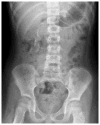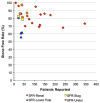Clinical practice: surgical approaches to urolithiasis in children
- PMID: 21190040
- PMCID: PMC4011548
- DOI: 10.1007/s00431-010-1373-6
Clinical practice: surgical approaches to urolithiasis in children
Abstract
The incidence of urolithiasis in children is increasing. Adequate knowledge of treatment modalities and surgical options is therefore essential for every pediatrician. Surgical approaches to urolithiasis in children continue to evolve with advancements in technology and sophistication of current equipment and techniques. Perhaps the most significant development in new techniques is the advent of robotic-assisted laparoscopy. This review, for the general pediatrician, summarizes the most recent pediatric data and guidelines for surgical approaches to treatment of urolithiasis.
Conflict of interest statement
Figures








Similar articles
-
Pediatric urolithiasis.Curr Opin Urol. 2009 Jul;19(4):419-23. doi: 10.1097/MOU.0b013e32832c9096. Curr Opin Urol. 2009. PMID: 19440153 Review.
-
Surgical management of urolithiasis - a systematic analysis of available guidelines.BMC Urol. 2018 Apr 10;18(1):25. doi: 10.1186/s12894-018-0332-9. BMC Urol. 2018. PMID: 29636048 Free PMC article.
-
Minimal access surgery in the management of pediatric urolithiasis.J Pediatr Urol. 2009 Feb;5(1):42-6. doi: 10.1016/j.jpurol.2008.07.011. Epub 2008 Sep 20. J Pediatr Urol. 2009. PMID: 18805739
-
The emerging role of robotics and laparoscopy in stone disease.Urol Clin North Am. 2013 Feb;40(1):115-28. doi: 10.1016/j.ucl.2012.09.005. Urol Clin North Am. 2013. PMID: 23177639 Review.
-
Management of pediatric stone disease.Curr Urol Rep. 2007 Mar;8(2):163-73. doi: 10.1007/s11934-007-0067-8. Curr Urol Rep. 2007. PMID: 17303023 Review.
Cited by
-
Robotic Management of Urolithiasis in the Pediatric Population.Front Pediatr. 2019 Aug 22;7:351. doi: 10.3389/fped.2019.00351. eCollection 2019. Front Pediatr. 2019. PMID: 31508400 Free PMC article. Review.
-
Is laparoscopic pyelolithotomy an alternative to percutaneous nephrolithotomy for treatment of kidney stones larger than 2.5 cm in pediatric patients?Pediatr Surg Int. 2023 Jan 11;39(1):78. doi: 10.1007/s00383-023-05367-4. Pediatr Surg Int. 2023. PMID: 36627447
References
-
- Ather MH, Noor MA. Does size and site matter for renal stones up to 30-mm in size in children treated by extracorporeal lithotripsy? Urology. 2003;61(1):212–215. S0090429502021283. discussion 215. - PubMed
-
- Badawy H, Salama A, Eissa M, et al. Percutaneous management of renal calculi: experience with percutaneous nephrolithotomy in 60 children. J Urol. 1999;162(5):1710–1713. S0022-5347(05)68220-1. - PubMed
Publication types
MeSH terms
Grants and funding
LinkOut - more resources
Full Text Sources

